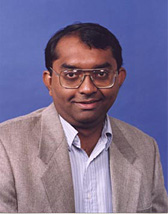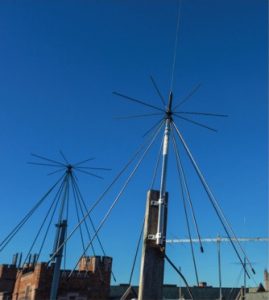
Professor Sumit Roy leads the Spectrum research.
On top of Sieg Hall, Electrical Engineering Professor Sumit Roy and his students have placed a commodity RF sensor station, which is capable of passively monitoring spectrum usage of over 300 MHz-6 GHz band (ultra-high frequency) occurring in the local vicinity. The integrated web interface currently allows remote users to access the data gathered by the sensors and stored on a public cloud service. Many of the sensors will be deployed in various metro areas in the country.
Roy developed the Spectrum monitoring system under an Early Concept Grant for Exploratory Research, which is based on a broader $400 million National Science Foundation’s (NSF) initiative to boost advanced wireless research. A key objective is more efficient reuse of scarce spectrum resources. Obtaining this objective relies on products that generate very large quantities of data. The data will be made publicly available to the R&D community interested in spectrum engineering for subsequent analysis, with the possibility of providing data-driven inputs for future spectrum policy.
“Given that supply of usable spectrum is increasing very slowly, relative to burgeoning demand (which is driven by all the bandwidth-hungry devices and apps, as well the increasing number of new consumers beginning to use data services on networks worldwide in developing nations), there is a great and urgent need for such refined policymaking,” Roy said. “A reasonable analogy is the scarcity of land in Manhattan. You can make Manhattan bigger; but only at great cost. Instead, a smarter initial starting point is to make better use of available land.”
Since spectrum use – like land – is divided into broadly civilian (cellular networks and unlicensed technologies, like Wi-Fi] and non-civilian (all the networks owned by the federal government) uses, a key policy question is how to apportion spectrum use into these two classes. In this sense, a few very interesting policy versus technology questions have come to the forefront in recent years concerning spectrum usage.
One question is what to do when it is determined that a “private” owner of some piece of spectrum (i.e. one with an exclusive license for its use) under-utilizes this scarce resource. Increasingly, there is a trend in policy circles to encourage sharing in such circumstances.
“Sharing would allow the licensee to keep its rights to the spectrum, but it would be obligated to ‘lease’ it temporarily to another network (under appropriate rules for sharing that includes protection for the licensee’s operations).” Roy said. “Overall, this leads to much more efficient use of spectrum, and that is what my research – including developing of the Spectrum Monitoring system – is broadly focused on. Through these efforts, we are placing Seattle at the forefront of the Smart Spectrum City prototype and providing a model for other cities to follow.”

The RF sensor station on the top of Sieg Hall at the University of Washington, Seattle.
Broadband Access & Public Services in the Internet Era
Broadband access is often used as a socio-economic metric in this Internet Age. Nations continue to be ranked on the broadband scale. While this greatly affects economic progress for developing economies looking to integrate with global markets and supply chains, it is also impacts developed market-driven societies as well.
“In the U.S., the percent of households with broadband internet connection is upward of 80 percent,” Roy said. “However, this access is geographically concentrated. Reliable access largely exists in dense urban areas where the Internet service providers can turn a profit, but many low density areas (rural or otherwise limited by geographic factors) are poorly served.”
The limited lack of broadband access in these areas restricts the effective delivery of public services that require a mature, robust and ubiquitous telecommunication network (i.e., better education and healthcare), thus reducing economic development and self-empowerment.
A significant gap is the absence of a unified public safety/emergency response network. Cheri Marusa is the President and Founder of Life Support, a nonprofit focused on improving medical services in Upper Kittitas County. She has worked with the Washington State House of Representatives for four years to advance policy work dedicated to broadband coverage.
“My concern and passion is for public safety,” Marusa said. “This encompasses: an individual calling 911, first responders arriving at an emergency scene, law enforcement coverage, the management of wild land fires and the access of telemedicine. I advocate for critical access to communication and enhanced technology. Because spectrum is a finite resource, the communications sector and legislative policy have to focus on identifying opportunities to make both commercial and federal Spectrum use more efficient.”
From a policy perspective, what should communities have access to at a base level? Spectrum sharing will allow for more efficient use of the resource, but for a deeply Internet-dependent society, the concept of baseline is not easily identifiable.
“We need to ask ourselves,” Roy said. “What are the basic things we should have access to that should be provided as a public good?”

